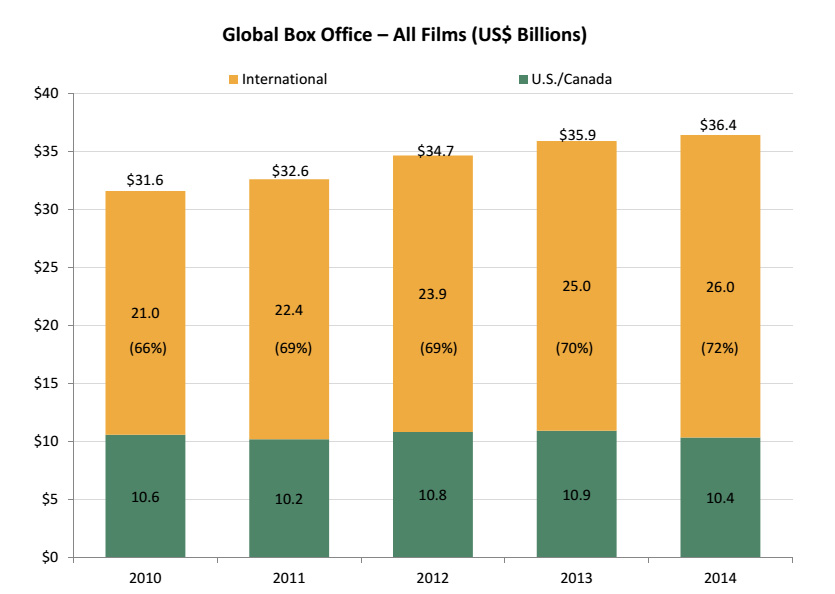So we have seen that the movie industry has set some incredible records in the last several years (read more here), and that the word of mouth, which is a fundamental reason for the short head, works overtime when it come to movies (read more here).
Now let’s fly a little higher and check some more macro aspects of the movie industry. For that purpose we shall take a look into the Theatrical Market Statistics 2012 that were published by the MPAA (motion picture association of America).
First of all it is good to know, especially for those in the movie industry, that the revenues are going up and that so is the number of digital screens and the price of an average movie ticket – the growth is bigger out side of the US but also domestic we see that the numbers go up.

But this is not what we are here for. We are here to check on the short head of the movies and see if and how the film makers react to it. The best way to learn about it is by checking the number of movies that were produced and released each year.
Oops.
In 2012, 677 movies were released in domestic theaters. This is a boost of 11% from 2011 and 49% from 2003.
Is this the sound of a tail getting longer?
Let’s go deeper.
549 of The 677 movies that were released in 2012 are non-members movies. Only 128 movies were released by MPAA members. MPAA members are the big 6 studios (Walt Disney Studios Motion Pictures, Paramount Pictures Corporation, Sony Pictures Entertainment, Inc. Twentieth Century Fox Film Corporation, Universal City Studios LLC, and Warner Bros. Entertainment Inc.) and their subsidiaries.
If we look at the number of movies that the MPAA members released over the years the picture is different – their 128 movies that were released in 2012 are a huge decrease from 141 in 2011 (9%) and from 180 in 2003 (29%).
In 2013 the number went down to 114 movies (in 2014 it got back up to 136).
The big studios are making fewer movies year after year and in the meantime the small studios have doubled their releases in the last 10 years.
It seems like the big 6 studios fully understand and follow the rules of the short head scene while the small studios are still reading the book about the long tail.
But who says that the big studios are right? Maybe there is a long tail in the movies and they don’t know it?
Mmmm. Don’t think so.
The pareto of Hollywood
So I looked into box office mojo again and checked all the revenues of all the studios and all the movies that were playing in 2012.
According to BOM (box office mojo) the top 7 studios (the 6 MPAA members and Lionsgate which is the biggest independent studio) had 205 movies in 2012 (156 new and 49 that were released in 2011 and still running).
These 205 movies made all together almost 10 billion dollars in 2012. Bear in mind that not all of their movies were hits. They had some major flops but they still managed to get almost 10 billion dollars (domestic).
All 802 movies that were playing in 2012, according to BOM, made less than 11 billion dollars. That means that the big 7 studios were responsible for more than 90% of the revenues!
7.69% of the studios, who had movies that were playing in 2012, took almost 100% of the revenues.
The other 92.3% of the studios hardly made any revenues…
The top grossing 10 movies in 2012 were responsible for 30% of the revenues. That means that 1.5% of the movies that were playing in 2012 made 30% of the revenues.
3.6% of the movies played in 2012 made more than 50% of the revenues.
Less than 15% of the movies made more than 90% of the revenues!

This is a nice short head but maybe it has always been this way?
So I turned back to BOM and checked the numbers of 2002.
Did the revenue split differently back then?
Apparently there was already a short head back then. The short head of 2012 seems only a bit bigger than the one in 2002.
But when we examine the market share (in revenues) as a function of the movies share (not the absolute 100 movies but the 15% of the movies that were published in the year) the picture is far more dramatic.
While in 2012 3.6% of the movies made 50% of the revenues, in 2002 it took almost 6% of the movies to reach 50% of the revenues.
While in 2012 14.3% of the movies made more than 90% of the revenues, in 2002 14.3% of the movies made less than 80%.

It appears that the movie industry has shifted towards the short head, leaving the long tail to the small and medium studios. These small studios are still making more and more movies, trying and sometime succeeding to make a hit, but their revenues as whole are almost meaningless (sounds like what is happening to the long tail musicians… they tour much more than the popular artists but make less revenues – read more here).
The big studios are making fewer films, investing more and more money in each of them; they know that at this era all they need is a small amount of huge hits.
“Taking notice of changing industry economics and shifting consumer tastes has been modifying that blueprint. His strategy involves making fewer but more ambitious movies”. that is The New York Times wrote in 2010 about Jeff Robinov, the former president of the Warner Brothers Pictures Group.
Steven Spielberg recently explained that in a panel at the University of Southern California that: “We can’t expand the week. We can’t expand the 24-hour cycle. So we’re stuck with so many choices. You’re at the point right now where a studio would rather invest $250 million in one film for a real shot at the brass ring, than make a whole bunch of really interesting, deeply personal — and even maybe historical — projects that may get lost in the shuffle because there’s only 24 hours”.
Spielberg, by the way, doesn’t think that this strategy will prevail: “There’s going to be an implosion where three or four or maybe even half a dozen of these mega-budgeted movies are going to go crashing into the ground and that’s going to change the paradigm again”.
But the short head isn’t a paradigm. It is a profound change in our economy – in the demand and supply. The consumers, or at least most of them, in this case the moviegoers, don’t really want a long tail. They want hits. On the other side we have the suppliers, in this case the studios, who are doing what is right for them – focus on a small amount of potential hits and meeting the demand.
If one or more studios would fall in the process it probably won’t really change a thing.



